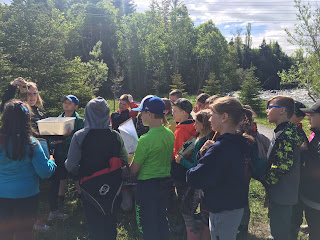Ten
years since the United Nations Climate Change Conference, most of the world agrees that climate change is real. Climate change scientists
are no longer asking “is this happening”, they are asking “was this weather event
worse because of climate change, and is there a way we can mitigate and adapt
so that the effects are less overwhelming”. But what does that look like? And
how are wetlands involved?
Welcome
to the first installment of the SAM blog series, Wetlands against Climate
Change: how wetlands contribute to mitigation and adaptation.
Humans
have contributed to climate change by increasing the rate of CO2 and other
greenhouse gases that have entered the atmosphere over the past century. Turn
on the news any night of the week and we can see the effects of climate change. Wildfires burning large areas of forests,
hurricanes taking out whole islands, and wildlife being pushed to survive in
quickly changing ecosystems are just a few examples. According to the Intergovernmental Panel on Climate Change (IPCC) even if we stopped all greenhouse gases from entering our atmosphere today,
climate change is going to continue to affect us and future generations.
In
the face of these extreme, and ever more common events, climate change scientists
and policy makers have been tossing around the terms Mitigation and Adaptation. But what do these words mean when you
are talking about climate change? What do they mean for your community? And how
do wetland ecosystems play a role?
Before
we answer all these questions, let’s start at the beginning by arming ourselves
with a full understanding of the terms Mitigation and Adaptation.
Mitigation is defined as reducing emissions and stabilizing the levels of greenhouse gases we allow into the atmosphere. Some examples listed by the IPCC are using more fuel-efficient and hybrid electric vehicles, creating limits on emissions for industry, using renewable energy resources like solar and wind power, reducing deforestation, and the restoration of peat soils (Wetlands!) . Over the past 30 years total greenhouse gas emissions have steadily risen. Mitigation would mean reducing those emissions and in turn reducing global temperature rise. Take a look at the graph by Sophie Lewis, Climate Scientist (Graph Taken from Sophie Lewis Twitter @aviandelights). The graph illustrates two scenarios (with and without mitigation efforts), and how climate change might affect future generations.
Mitigation is defined as reducing emissions and stabilizing the levels of greenhouse gases we allow into the atmosphere. Some examples listed by the IPCC are using more fuel-efficient and hybrid electric vehicles, creating limits on emissions for industry, using renewable energy resources like solar and wind power, reducing deforestation, and the restoration of peat soils (Wetlands!) . Over the past 30 years total greenhouse gas emissions have steadily risen. Mitigation would mean reducing those emissions and in turn reducing global temperature rise. Take a look at the graph by Sophie Lewis, Climate Scientist (Graph Taken from Sophie Lewis Twitter @aviandelights). The graph illustrates two scenarios (with and without mitigation efforts), and how climate change might affect future generations.
Adaptation, according to The Federation of Canadian Municipalities, refers to “any modification in a
system or process established by communities in order to address uncertainties
related to climate change”.
Examples of adaptation include using water resources more efficiently, adapting
building codes to withstand severe weather events, developing food crops that
are drought resistant, and the creation of wetlands as a buffer against sea
level rise and flooding (Wetlands again! see the picture below). Adapting to climate change must
involve people from a diverse array of backgrounds and expertise, including
engineers, health professionals, farmers, city planners, political leaders, and
policy makers.
Climate
change scientists have agreed that we need to take action! One key, and
sometimes overlooked, area for mitigation and adaptation are wetlands. Join us
for our next Wetlands against Climate Change blog post “Perfectly Peaty: how peat moss is an amazing carbon
sink!”
Images:
https://climate.nasa.gov/solutions/adaptation-mitigation/
Graph Taken from Sophie Lewis Twitter @aviandelights
http://www.ducks.ca/our-work/wetlands/
Resources:
https://www.ramsar.org/news/wetlands-the-hidden-resource-for-climate-mitigation-and-adaptation
https://www.scientificamerican.com/article/wetlands-can-help-fight-climate-change/
https://www.canadiangeographic.ca/article/canadas-boreal-wetlands-are-key-fighting-climate-change-report



























